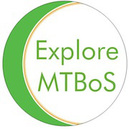- One teacher's story of moving towards inquiry-based learning and peer collaboration in the math classroom.
I want to start out with some pictures of my classroom from this past year. My goal in showing you these isn't so that you think I’m some wonderful teacher; it’s to give weight to what I’m saying. If I can do it, you can do it. [Pictures are located in the pdf at the bottom of the post if you're interested]
Several years back, I went to Western Michigan to get my Master’s degree in math education. When confronted with the research, it’s not hard to see the value in inquiry-based learning coupled with rich contexts in the math classroom. By “inquiry-based” I mean students are investigating mathematical relationships and making conjectures; they’re getting messy with the math.
However, shifting my teaching has been a much more difficult process. It’s not that I didn't want to do it; I didn't know where to start. Having the opportunity to teach from Core Plus for a couple of years was helpful but I wasn't trained in the process. Students were frustrated. I was frustrated. Then life happened: my school shifted curriculums, the State changed standards, I bounced around to a couple of different schools (my wife changed jobs, budget cuts, etc), I had kids, etc.
I spent years collecting interesting real-world contexts for my lessons but still had this underlying guilt that I wasn't doing it right. My classes did fine compared to other math classes but my students weren't actively engaged in exploring the material.
I decided to change that.
Start small. I don’t use problems or tasks for every topic. I still use direct instruction for some ideas. My initial goal was to incorporate at least 2 rich contexts or activities into each chapter for Algebra 1 and Algebra 2.
Online Resources to get you started:
I know 3-Act tasks are Dan's claim to fame but what I appreciate most about Dan is his reworking of textbook tasks.
He also has a mantra I find helpful:
- Get buy in from the students.
- Go up the ladder of abstraction.
- Be less helpful.
- She has some great investigatory tasks for Middle School and Algebra 1.
- In her blog she models productive class conversations about math.
- This is the place to start: EmergentMath.com
- Common Core Problem Based Curriculum Maps from 5th grade through high school
- Treasure trove of tasks to get you started—especially Algebra 2 (those can be hard)
Twitter has been my best professional development decision in my 14 years of teaching.
#MTBoS (Math Twitter Blog-o-Sphere)
- This is THE place I've found where math teachers gather and share ideas freely. This isn't about sharing what you had for dinner.
#alg2chat
#MSMathChat – Mondays 7pm MST
- Middle School Math Teachers from around the nation get together to discuss topics (voted on beforehand) about how to best approach topics in middle school math classes.
5 Practices for Orchestrating Productive Mathematics Discussions by Margaret S. Smith and Mark K. Stein.
This book has been hands down the best resource I've come across for helping me structure productive discussions in my classes. I’m sure I read something in my masters studies coming close to this, but maybe I just wasn't ready for it. Buy this book!
| Here's a summary article on orchestrating classroom math discussions. It's not as detailed as the book but it's a good place to start. |
| ||
Evernote and Evernote Web Clipper
Organize everything you come across no matter what device or browser you happen to be using.
Use tags to help find resources in the future: “Alg2, Quadratic, Activity, PrBL”
The Web Clipper is THE best resource because no matter what device I'm using (work computer, laptop, tablet, phone) I can gather the resources I stumble across into one location along with my initial thoughts about how I might use the resource without having to change devices or spend more than 1 minute doing so. Brilliant.
Create a general outline of what you currently do for your course. What topics to you teach? When do you teach them (i.e. chapters or units)? This takes a couple of hours but helps you organize your resources and keeps you from spinning your wheels.
Twice a year (or more) go through your accumulated resources in Evernote and find a spot for them to go in your course. Be specific! Find the exact lesson you will replace this with. And if you already have a stellar lesson, don't keep the bad ideas. Only keep the top two or three resources. Sometimes having too many options is just as bad as having no options.
Here's a previous blog post I wrote about keeping web resources organized.
With a little bit of effort, your textbook can be a good source for rich tasks.
- Project section at the end of the chapters
- Extension questions at the end of each section’s problem sets
Rather than have you listen to me talk about how to rework a task, we're going to try it. We will use the Flashlights and Variation Equations lesson from the Core Plus Mathematics Project, Course 2, pg 10 (used with permission). I would probably use this early in the year with Algebra 2 or late in the year with Algebra 1.
How can we make the task more accessible?
- Can we delay the abstraction until later on?
- Can we reduce the literacy demand?
- Can we create an intellectual need?
- Students who complete this task do it because we tell them to, not because they’re interested.
- Can we create a 3 Act lesson out of this?
| making_math_awesomer_presentation-bvsd_pdf.pdf |
 RSS Feed
RSS Feed



